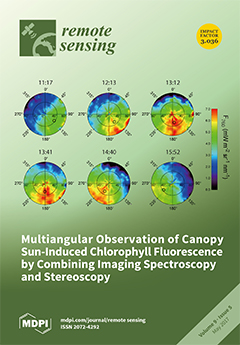As a primary basic gas in the atmosphere, atmospheric ammonia (NH
3) plays an important role in determining air quality, environmental degradation, and climate change. However, the limited ground observation currently presents a barrier to estimating ground NH
3 concentrations on a
[...] Read more.
As a primary basic gas in the atmosphere, atmospheric ammonia (NH
3) plays an important role in determining air quality, environmental degradation, and climate change. However, the limited ground observation currently presents a barrier to estimating ground NH
3 concentrations on a regional scale, thus preventing a full understanding of the atmospheric processes in which this trace gas is involved. This study estimated the ground NH
3 concentrations over China, combining the Infrared Atmospheric Sounding Interferometer (IASI) satellite NH
3 columns and NH
3 profiles from an atmospheric chemistry transport model (CTM). The estimated ground NH
3 concentrations showed agreement with the variability in annual ground NH
3 measurements from the Chinese Nationwide Nitrogen Deposition Monitoring Network (NNDMN). Great spatial heterogeneity of ground NH
3 concentrations was found across China, and high ground NH
3 concentrations were found in Northern China, Southeastern China, and some areas in Xinjiang Province. The maximum ground NH
3 concentrations over China occurred in summer, followed by spring, autumn, and winter seasons, which were in agreement with the seasonal patterns of NH
3 emissions in China. This study suggested that a combination of NH
3 profiles from CTMs and NH
3 columns from satellite obtained reliable ground NH
3 concentrations over China.
Full article





